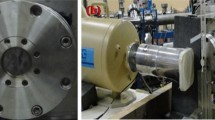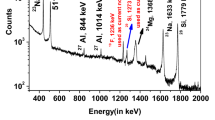Abstract
External (in-air) Particle Induced Gamma-ray Emission (PIGE) setup of FOlded Tandem Ion Accelerator (FOTIA), Bhabha Atomic Research Centre (BARC) was utilized for determining concentrations of low Z elements (Si, Na, Al and F) in geological samples by a simple and novel sample preparation method using thin Mylar films to pack direct solid samples. Low energy proton beam was utilized and the current-normalized count rates of analytes were obtained using the count rate of tantalum, the beam exit window material. Meticulousness of the method was ascertained by analysing different CRMs and compared with conventional pelletisation method. Proposed method was adopted for elemental analysis in uranium ore samples for possible nuclear forensic applications.



Similar content being viewed by others
References
Räisänen J, Witting T, Keinonen J (1987) Absolute thick-target γ-ray yields for elemental analysis by 7 and 9 MeV protons, Nucl Instrum Methods Phys Res B 28(2):199–204. DOI:https://doi.org/10.1016/0168-583x(87)90105-4
Volfinger M, Robert J L (1994) Particle-induced-gamma-ray-emission spectrometry applied to the determination of light elements in individual grains of granite minerals. J Radioanal Nucl Chem 185:273–291. DOI:https://doi.org/10.1007/bf02041301
Valković O, Jakšić M, Fazinić S, Valković V, Moschini G, Menapace E (1995) Quality control of PIXE and PIGE nuclear analytical techniques in geological and environmental applications. Nucl Instrum Methods Phys Res B 99:372–375. DOI:https://doi.org/10.1016/0168-583X(95)00230-8
Chhillar S, Acharya R, Pai R V, Sodaye S, Mukerjee S K, Pujari P K (2012) A simple and sensitive particle induced gamma-ray emission method for non-destructive quantification of lithium in lithium doped Nd2Ti2O7 ceramic sample. J Radioanal Nucl Chem 293:437–441. DOI: https://doi.org/10.1007/s10967-012-1764-4
Dasari K B, Chhillar S, Acharya R, Ray D K, Behera A, Lakshmana Das N, Pujari P K (2014) Simultaneous determination of Si, Al and Na concentrations by particle induced gamma-ray emission and applications to reference materials and ceramic archaeological artifacts. Nucl Instrum Methods Phys Res B 39:37–41. DOI:https://doi.org/10.1016/j.nimb.2014.08.017
Srivastava A, Chhillar S, Singh D, Acharya R, Pujari P K (2014) Determination of fluorine concentrations in soil samples using proton induced gamma-ray emission. J Radioanal Nucl Chem 302:1461–1464. DOI:https://doi.org/10.1007/s10967-014-3661-5
Chhillar Sumit, Acharya R, Tripathi R, Sodaye S, Sudarshan K, Rout P C, Mukerjee S K, Pujari P K (2015) Compositional characterization of lithium titanate ceramic samples by determining Li, Ti and O concentrations simultaneously using PIGE at 8 MeV proton beam. J Radioanal Nucl Chem 305:463–467. DOI:https://doi.org/10.1007/s10967-015-4037-1
Tamilarasu S, Velraj G, Ray D K, Acharya R (2016) Chemical analysis of archaeological clay potteries by PIGE and PIXE methods using proton beams from tandem accelerator for provenance study. J Radioanal Nucl Chem 310:363–370. DOI:https://doi.org/10.1007/s10967-016-4842-1
Chhillar S, Acharya R, Mishra R K, Kaushik C P, Pujari P K (2017) Simultaneous determination of low Z elements in barium borosilicate glass samples by in-situ current normalized particle induced gamma-ray emission methods. J Radioanal Nucl Chem 312:567–576. DOI:https://doi.org/10.1007/s10967-017-5251-9
Acharya R, Pujari P K (2019) Potential of conventional and internal monostandard NAA and PGNAA and PIGE in forensic sciences: An overview. Forensic Chem 12:107–116. DOI:https://doi.org/10.1016/j.forc.2018.01.002
Sharma V, Acharya R, Hemlata K, Bagla, Pujari P K (2021) Standardization of an external (in-air) PIGE methodology using tantalum as a current normalizer in conjunction with INAA for rapid and non-destructive chemical characterization of “as-received” glass fragments towards forensic applications. J Anal At Spectrom 36:630–643. DOI: https://doi.org/10.1039/d0ja00482k
Sharma V, Acharya R, Samanta S K, Goswami M, Bagla H K, Pujari P K (2019) Chemical characterization of soda-lime glass samples by in-situ current normalised PIGE and conventional INAA methods for forensic applications. J Radioanal Nucl Chem 323:1451–1457. DOI:https://doi.org/10.1007/s10967-019-06926-7
Samanta S K, Sengupta A, Ghorui S, Acharya R, Pujari P K (2022) The standardization and application of an external (in air) particle induced gamma emission (PIGE) method for the rapid and non-destructive quantification of light elements at major to trace concentrations in coal, bottom ash and coke samples. J Anal At Spectrom 37:296–305. DOI:https://doi.org/10.1039/D1JA00309G
Wasim Raja S K, Vishal Sharma, Samanta S K, Acharya R, Tammana S R C, Murthy S, Majumdar, Pujari P K (2022) Development of an innovative external (in air) Particle Induced Gamma-ray Emission method for rapid non-destructive determination of isotopic composition of boron in “As received” boron based ceramic neutron absorbers. Anal Chim Act 1202:339686 DOI:https://doi.org/10.1016/j.aca.2022.339686
Sharma V, Sarkar A, Acharya R, Bagla H K, Pujari P K (2022) Utilization of accelerator and reactor based nuclear analytical techniques for chemical characterization of automobile windshield glass samples and potential of statistical analyses using trace elements towards glass forensics. Forensic Sci Int 334:111262. DOI:https://doi.org/10.1016/j.forsciint.2022.111262
Rosenberg R J, Zilliacus R (1993) Determination of impurities in nuclear fuel element components by neutron activation analysis. J Radioanal Nucl Chem Articles 169(1):113–124. DOI: https://doi.org/10.1007/bf02046789
Oliveira Junior O P, Sarkis J E S (2002) Determination of impurities in uranium oxide by inductively coupled plasma mass spectrometry (ICPMS) by the matrix matching method. J Radioanal Nucl Chem 254(3):519–526. DOI: https://doi.org/10.1023/a:1021642122066
Varga Zsolt,Wallenius Maria, Klaus M, Elizabeth K, Millet Sylvain (2009) Application of Lead and Strontium Isotope Ratio Measurements for the Origin Assessment of Uranium Ore Concentrates. Anal Chem 81:8327–8334. DOI:https://doi.org/10.1021/ac901100e
Keegan E, Richter S, Kelly I, Wong H, Gadd P, Kuehn H, Adolfo Alonso-Munoz (2008) The provenance of Australian uranium ore concentrates by elemental and isotopic analysis. Appl Geochem 23:765–777. DOI:https://doi.org/10.1016/j.apgeochem.2007.12.004
Keegan Elizabeth M, Wallenius K, Mayer Z, Varga G Rasmussen (2012) Attribution of uranium ore concentrates using elemental and anionic data. Appl Geochem 27:1600–1609. DOI: https://doi.org/10.1016/j.apgeochem.2012.05.009
Keegan Elizabeth, Kristo Michael J, Colella Michael, Robel Martin, Williams Ross, Lindvall Rachel, Eppich Gary, Roberts Sarah, Borg Lars, Gaffney Amy, Plaue Jonathan, Wong Henri, Davis Joel, Loi Elaine, Reinhard Mark, Hutcheon Ian (2014) Nuclear forensic analysis of an unknown uranium ore concentrate sample seized in a criminal investigation in Australia. Foren Sci Int 240:111–121. DOI: https://doi.org/10.1016/j.forsciint.2014.04.004
Kristo Michael Joseph, Keegan Elizabeth, Colella Michael, Williams Ross, Lindvall, Rachel, Eppich Gary, Roberts Sarah, Borg Lars, Gaffney Amy, Plaue Jonathan, Knight Kim, Loi Elaine, Hotchkis Michael, Moody Kenton, Singleton Michael, Robel Martin, Hutcheon Ian (2015) Nuclear forensic analysis of uranium oxide powders interdicted in Victoria, Australia. Radiochim Acta 103(7):487–500. DOI: https://doi.org/10.1515/ract-2014-2363
Kristo Michael J, Gaffney Amy M, Marks Naomi, Knight Kim, Cassata William S, Hutcheon Ian D (2016) Nuclear Forensic Science: Analysis of Nuclear Material Out of Regulatory Control. Annu Rev Earth Planet Sci 44:555–579. DOI: https://doi.org/10.1146/annurev-earth-060115-012309
Balboni Enrica, Nina Jones, Tyler Spano, Antonio Simonetti, Burns Peter (2016) Chemical and Sr isotopic characterization of North America uranium ores: Nuclear forensic applications. Appl Geochem 74:24–32. DOI:https://doi.org/10.1016/j.apgeochem.2016.08.016
Apostol A I, Pantelica A, Ortega-Feliu I, Marginean N, Sima O, Straticiuc M, Jimenez-Ramos M C, Fugaru V (2017) Ion beam analysis of elemental signatures in uranium dioxide samples: importance for nuclear forensics. J Radioanal Nucl Chem 311:1339–1346. DOI:https://doi.org/10.1007/s10967-016-5136-3
Mukhopadhyay P K (2001) The operating software of the PHAST PC-MCA card, Proc. of Symposium on Intelligent Nuclear Instrumentation (INIT-2001), Mumbai, India, 307–310.
James Ziegler F, Ziegler M D, Biersack J P (2010) SRIM – The stopping and range of ions in matter. Nucl Instrum Methods Phys Res B: Beam Interact Mater At 268(11–12):1818–1823. DOI:https://doi.org/10.1016/j.nimb.2010.02.091
Acknowledgements
The authors would like to thank Dr. D K Aswal, Director, HS&EG, BARC, Dr. P K Pujari, Former Director, RC&IG, BARC, Head, RCD, Head, RSSD and Head, EMAD for their support and encouragements. Authors thank FOTIA operation members, OIC, FOTIA, Head, FOTIA, Section and AD, MRG and Head, IADD, BARC for their support during experiment.
Author information
Authors and Affiliations
Ethics declarations
Conflict of interest
The authors have no conflicts of interests to declare.
Additional information
Publisher’s Note
Springer Nature remains neutral with regard to jurisdictional claims in published maps and institutional affiliations.
Rights and permissions
Springer Nature or its licensor holds exclusive rights to this article under a publishing agreement with the author(s) or other rightsholder(s); author self-archiving of the accepted manuscript version of this article is solely governed by the terms of such publishing agreement and applicable law.
About this article
Cite this article
Ravi K, P., Sreejith, S.R., Mishra, S. et al. Development of a simple non-destructive method to quantify low Z elements in ore samples using tantalum as an external current normalizer in external (in-air) PIGE method for Nuclear Forensic applications. J Radioanal Nucl Chem 331, 4369–4376 (2022). https://doi.org/10.1007/s10967-022-08506-8
Received:
Accepted:
Published:
Issue Date:
DOI: https://doi.org/10.1007/s10967-022-08506-8




